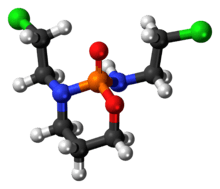Ifosfamide
-ifosfamide.svg.png) | |
|
(R)-(+)- and (S)-(−)-ifosfamide (top), (S)-(−)-ifosfamide (bottom) | |
| Clinical data | |
|---|---|
| Pronunciation | /aɪˈfɒsfəˌmaɪd/ |
| Trade names | Ifex |
| AHFS/Drugs.com | Monograph |
| MedlinePlus | a695023 |
| Pregnancy category | |
| Routes of administration | intravenously |
| ATC code | L01AA06 (WHO) |
| Legal status | |
| Legal status | |
| Pharmacokinetic data | |
| Bioavailability | 100% |
| Metabolism | Hepatic |
| Biological half-life | 60-80% in 72 hours |
| Excretion | Renal |
| Identifiers | |
| |
| Synonyms | 3-(2-chloroethyl)-2-[(2-chloroethyl)amino]tetrahydro-2H-1,3,2-oxazaphosphorine 2-oxide |
| CAS Number |
3778-73-2 |
| PubChem (CID) | 3690 |
| IUPHAR/BPS | 7201 |
| DrugBank |
DB01181 |
| ChemSpider |
3562 |
| UNII |
UM20QQM95Y |
| KEGG |
D00343 |
| ChEBI |
CHEBI:5864 |
| ChEMBL |
CHEMBL1024 |
| ECHA InfoCard | 100.021.126 |
| Chemical and physical data | |
| Formula | C7H15Cl2N2O2P |
| Molar mass | 261.1 g mol−1 |
| 3D model (Jmol) | Interactive image |
| |
| |
| (verify) | |
Ifosfamide (also marketed as Ifex) is a nitrogen mustard alkylating agent used in the treatment of cancer.[1] It is sometimes abbreviated as "IFO".[2]
It is on the WHO Model List of Essential Medicines, the most important medications needed in a basic health system.[3]
Medical uses
It is given as a treatment for a variety of cancers, including:
- Testicular cancer
- Breast cancer
- Lymphoma (Hodgkin and non-Hodgkin)
- Soft tissue sarcoma
- Osteosarcoma or bone tumor
- Lung cancer
- Cervical cancer
- Ovarian cancer
Administration
It is a white powder which, when prepared for use in chemotherapy, becomes a clear, colorless fluid. The delivery is intravenous.
Ifosfamide is often used in conjunction with mesna to avoid internal bleeding in the patient, in particular hemorrhagic cystitis.
Ifosfamide is given quickly, and in some cases can be given as quickly as an hour.
Side effects
Hemorrhagic cystitis is rare when ifosfamide is given with mesna. A common and dose-limiting side effect is encephalopathy (brain dysfunction).[4] It occurs in some form in up to 50% of people receiving the agent. The reaction is probably mediated by chloroacetaldehyde, one of the breakdown products of the ifosfamide molecule, which has chemical properties similar to acetaldehyde and chloral hydrate. The symptoms of ifosfamide encephalopathy can range from mild (difficulty concentrating, fatigue), to moderate (delirium, psychosis), to severe (nonconvulsive status epilepticus or coma). In children, this can interfere with neurological development. Apart from the brain, ifosfamide can also affect peripheral nerves. The severity of the reaction can be classified according to either the National Cancer Institute or the Meanwell criteria (grade I-IV). Previous brain problems and low levels of albumin in the blood increase the likelihood of ifosfamide encephalopathy. In most cases, the reaction resolves spontaneously within 72 hours. If it develops during an infusion of the drug, discontinuing the infusion is advised. The most effective treatment for severe (grade III-IV) encephalopathy is an intravenous solution of methylene blue, which appears to shorten the duration of encephalopathy; the exact mechanism of action of methylene blue is unclear. In some cases, methylene blue may be used as a prophylaxis before further doses of ifosfamide are administered. Other treatments include albumin and thiamine, and dialysis as a rescue modality.[4]
Ifosfamide may also cause a normal anion gap acidosis, specifically renal tubular acidosis type 2.[5]
References
- ↑ Takimoto CH, Calvo E. "Principles of Oncologic Pharmacotherapy" in Pazdur R, Wagman LD, Camphausen KA, Hoskins WJ (Eds) Cancer Management: A Multidisciplinary Approach. 11 ed. 2008.
- ↑ Jahnke K, Thiel E, Bechrakis NE, et al. (December 2008). "Ifosfamide or trofosfamide in patients with intraocular lymphoma". J. Neurooncol. 93 (2): 213–7. doi:10.1007/s11060-008-9761-8. PMID 19099202.
- ↑ "19th WHO Model List of Essential Medicines (April 2015)" (PDF). WHO. April 2015. Retrieved May 10, 2015.
- 1 2 Ajithkumar T, Parkinson C, Shamshad F, Murray P (March 2007). "Ifosfamide encephalopathy". Clin Oncol (R Coll Radiol). 19 (2): 108–14. doi:10.1016/j.clon.2006.11.003. PMID 17355105.
- ↑ Foster, Corey, ed. (2010). The Washington Manual of Therapeutics (33 ed.). Wolters Kluwer | Lippincott Williams & Wilkins. p. 407.
External links
- ACS Drug Guide: Ifosfamide
- Harvard Medical School Health Information on Ifosfamide
- MedlinePlus Drug Information
- BC Cancer Agency Ifosamide Information (Professional)
- RxList Online Drug Index Ifosamide Listing
